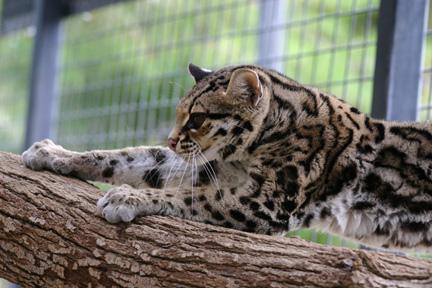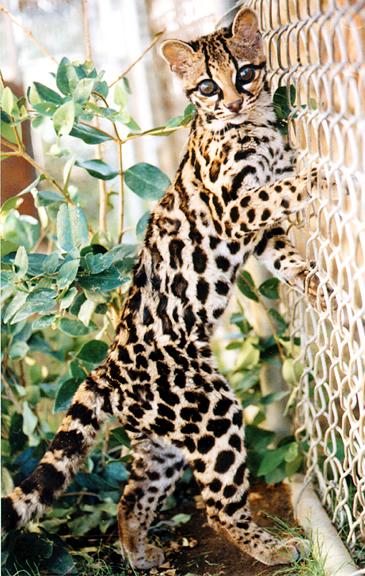
Stamped for your approval
Margay
Leopardus weidii
Leopardus weidii
Diet and Behavior
I'm Hungry...Where's the Caf?
The margay is a highly arboreal animal and spends the majority of its life in the trees. Thus its
|
prey, discovered
mainly through fecal analysis,
are also tree dwellers and
include squirrels, opossums,
arthropods(insects), small
birds, rats, mice, and a variety
of other small arboreal
organisms. Spread Em' For being such a small animal, about the size of a housecat, the margay has quite a large spread. By this I mean the amount of area that it routinely covers, what is more or less its homeland. A study sponsored by the Oklahoma City Zoo concluded the average range of a margay to be about 4.03 km2. The study |
 Photo, used with permission, by Nancy Vandermey |
| collected data via radio telemetry after eight margays, five male and three female, were captured and radio collared. Along with discovering the range of the margay, researchers were also able to detect the margays peak levels of activity, which occurred between 1600 and 400. The lowest levels of activity occurred at 1200 where the animals were found residing high in the canopy, resting. |
 Photo, used with permission, by Nancy Vandermey |
How Do I Respond to That? The margay show a collection of responses to specific stimuli. When certain odors are discovered, margays often rub their chin and cheeks on the scented areas. Flehmen is a reaction that occurs when urine is sensed, this reaction is characterized by lip curling and head raising. When obnoxious odors are present, the responses often seen are squinting eyes or the dropping of food. Margay also have a variety of vocalizations used to display their emotional state. Eight distinct sounds have been discovered and |
| include purring, meowing, bark/meowing, moaning, hissing, spitting, growling, and snarling used in various intensities to show their mood. When feeling threatened, the margay arches its back and |
|
raises the hair
on its back and erected tail. (right) The margay is a highly solitary individual, until obviously, it's time to mate, then the hunt is on. The estrous cycle of the margay is usually 32-36 days long, and the heat of each period is 4-10 |
 Photo, used with permission, by Nancy Vandermey |
|
Copyright © 2007, Design by: Sunlight webdesign
